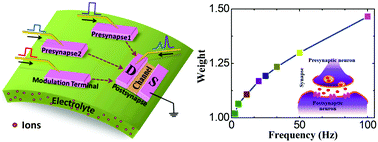Electric-double-layer transistors for synaptic devices and neuromorphic systems
Abstract
Compared with the traditional von Neumann architecture, neural systems have many distinctive properties including parallelism, low-power consumption, fault tolerance, self-learning, and robustness. Inspired by biological neural computing, neuromorphic systems may open up new paradigms to deal with complicated problems such as pattern recognition and classification, bipedal locomotion controlling, and decision making. Although two-terminal memristors can perform some basic synaptic and neural functions, our human brain contains many more synapses than neurons. This fact suggests that multi-terminal devices are more favourable for complex neural network emulation. In recent years, multi-terminal electric-double-layer transistors (EDLTs) based on interfacial ion-modulation have attracted significant attention in mimicking synaptic dynamic plasticity and neural functions. In this article, we will give a review of the recent progress and major trends in the field of EDLTs for synaptic devices and neuromorphic systems. Starting with a brief introduction of synaptic plasticity and neural functions in biological neural systems and electric-double-layer (EDL) modulation, we review the advances in the field of synaptic functions realized by EDLTs. At last, some of the challenges for the ultimate goal of brain-like computation and the possible solutions are also listed.

- This article is part of the themed collection: Recent Review Articles


 Please wait while we load your content...
Please wait while we load your content...